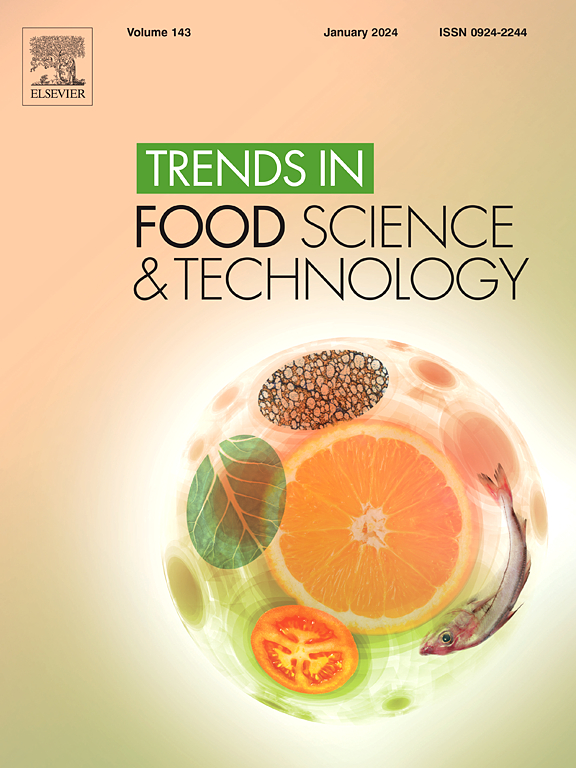Pediococcus pentosaceus in fermented Foods: Probiotic properties and a multi-omics framework for applications
IF 15.4
1区 农林科学
Q1 FOOD SCIENCE & TECHNOLOGY
引用次数: 0
Abstract
Background
Pediococcus pentosaceus, an emerging lactic acid bacterium (LAB) strain, is widely distributed in various fermented foods, functioning as part of the indigenous microbiota or as a starter culture to enhance the flavor, nutritional value, and product safety. Although many strains have well-documented probiotic properties, the underlying molecular mechanisms remain partially understood, limiting their optimized application in fermented food production and probiotic development.
Scope and approach
This review presents a comprehensive synthesis of current research on P. pentosaceus derived from diverse fermented foods, emphasizing its probiotic traits such as gastrointestinal resilience, antimicrobial activity, antioxidant properties, and immunomodulatory effects. Recent advances in multi-omics technologies, including genomics, transcriptomics, proteomics, and metabolomics, have enabled insights into key genes, metabolic pathways, and adaptive mechanisms underlying the functional traits of P. pentosaceus. The review further discusses integrative multi-omics strategies supporting the application of P. pentosaceus as a probiotic starter culture in food fermentation and highlights the prospects for precision fermentation and next-generation functional foods.
Key findings and conclusions
Herein, we systematically summarize recent integrated multi-omics studies that reveal key probiotic features, supporting the rational selection and optimization of P. pentosaceus strains for food fermentation and probiotic use. These approaches have revealed key genes, metabolic pathways, and regulatory networks related to flavor formation, environmental adaptation, and the production of bioactive compounds. However, challenges remain, including data integration, validation of predicted functions, and industrial scalability. Addressing these issues will expand the application potential of P. pentosaceus in developing functional food and individualized nutrition.
发酵食品中的戊糖球菌:益生菌特性和应用的多组学框架
戊糖pediococcus pentosaceus是一种新兴的乳酸菌(LAB),广泛分布于各种发酵食品中,作为本地微生物群的一部分或作为发酵剂来增强风味,营养价值和产品安全性。尽管许多菌株具有良好的益生菌特性,但其潜在的分子机制仍不完全清楚,这限制了它们在发酵食品生产和益生菌开发中的优化应用。本文综述了从各种发酵食品中提取的戊糖假单胞菌的研究现状,重点介绍了其胃肠道恢复力、抗菌活性、抗氧化性能和免疫调节作用等益生菌特性。包括基因组学、转录组学、蛋白质组学和代谢组学在内的多组学技术的最新进展,使人们能够深入了解P. pentosaceus功能性状背后的关键基因、代谢途径和适应机制。本文进一步讨论了支持P. pentosaceus作为益生菌发酵剂在食品发酵中的应用的综合多组学策略,并强调了精准发酵和下一代功能食品的前景。本文系统总结了近年来的综合多组学研究,揭示了益生菌的关键特征,为合理选择和优化戊糖假单胞菌菌株用于食品发酵和益生菌利用提供了依据。这些方法揭示了与风味形成、环境适应和生物活性化合物产生相关的关键基因、代谢途径和调控网络。然而,挑战仍然存在,包括数据集成、预测功能的验证和工业可伸缩性。这些问题的解决,将扩大戊索菌在开发功能食品和个性化营养方面的应用潜力。
本文章由计算机程序翻译,如有差异,请以英文原文为准。
求助全文
约1分钟内获得全文
求助全文
来源期刊

Trends in Food Science & Technology
工程技术-食品科技
CiteScore
32.50
自引率
2.60%
发文量
322
审稿时长
37 days
期刊介绍:
Trends in Food Science & Technology is a prestigious international journal that specializes in peer-reviewed articles covering the latest advancements in technology, food science, and human nutrition. It serves as a bridge between specialized primary journals and general trade magazines, providing readable and scientifically rigorous reviews and commentaries on current research developments and their potential applications in the food industry.
Unlike traditional journals, Trends in Food Science & Technology does not publish original research papers. Instead, it focuses on critical and comprehensive reviews to offer valuable insights for professionals in the field. By bringing together cutting-edge research and industry applications, this journal plays a vital role in disseminating knowledge and facilitating advancements in the food science and technology sector.
 求助内容:
求助内容: 应助结果提醒方式:
应助结果提醒方式:


